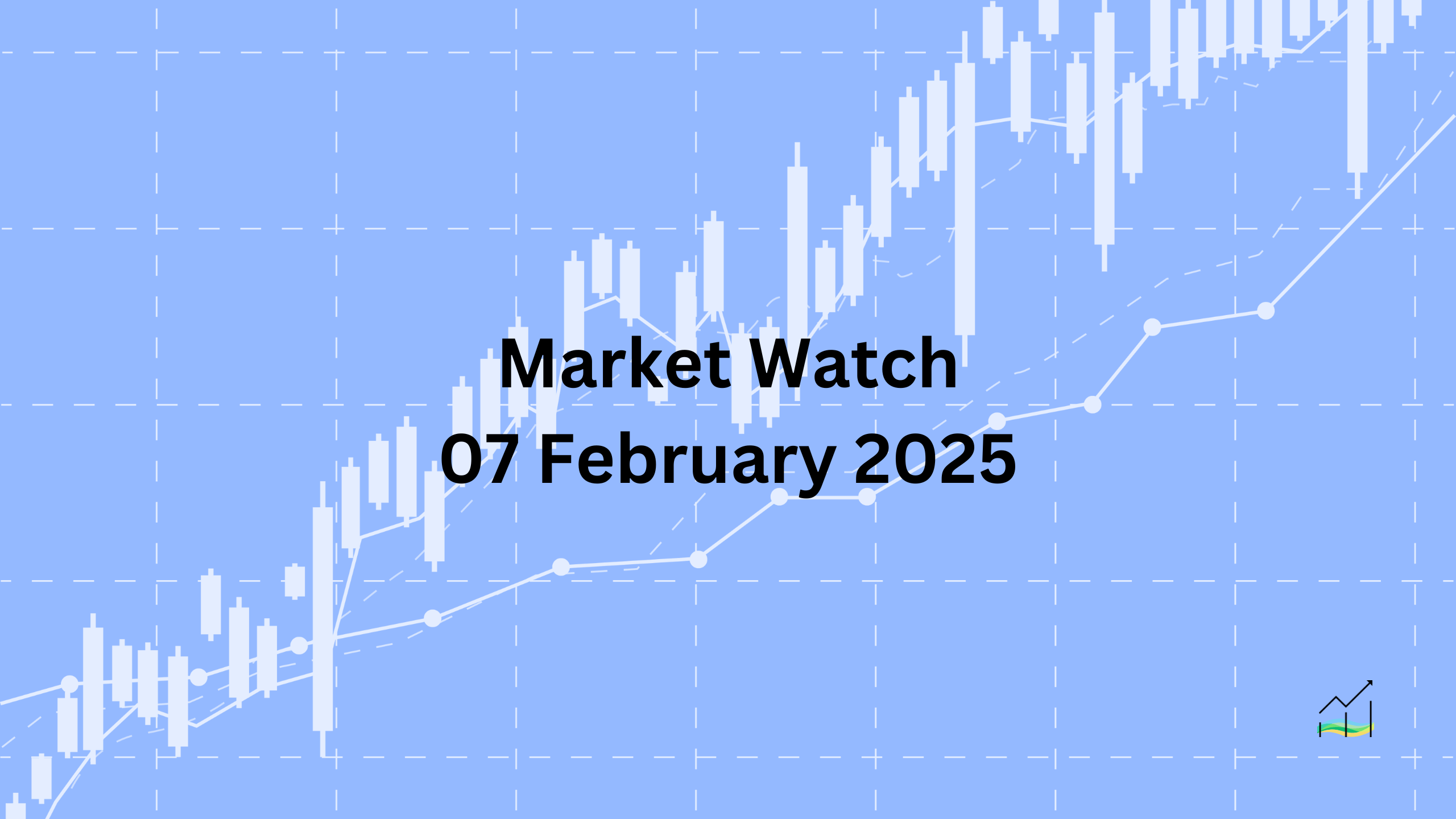07/02/2025 Market Watch

Market Caution Ahead of U.S. Jobs Data
The week started with heightened uncertainty as the US threatened new tariffs but later postponed them for a month. In the forex market, trading remains within narrow ranges as investors await the US jobs data. However, the report is expected to be distorted due to severe weather conditions and the California wildfires. Despite this, the Federal Reserve is unlikely to adjust its stance, remaining on hold at least until mid-year.
Equity markets are showing weakness today. Most major Asia-Pacific indices declined, except for China, Hong Kong, and Taiwan. In Europe, the Stoxx 600, which gained 1.2% yesterday, is struggling to maintain momentum, while US futures are also trading lower. Bond yields in Europe are slightly softer, with the US 10-year Treasury yield stable around 4.43%.
Gold prices are holding gains, staying near yesterday’s high of $2,873. China’s central bank has continued its gold purchases for the third consecutive month in January after pausing for six months. Meanwhile, oil markets remain under pressure. March WTI crude dropped to a new low of just under $70.50 before recovering above $71.00. However, resistance near $71.85 and the 200-day moving average around $72.00 remains intact.
United States of America
Overview
The US employment report is the main event, but it is unlikely to shift the market’s outlook on Federal Reserve policy. The Fed is expected to remain on hold until June or July, with rate cut expectations unchanged at 43 basis points for the year. The labor market continues to show signs of slowing, with job growth moderating compared to last year. Investors will also watch the University of Michigan’s sentiment survey for inflation expectations after a sharp jump in January.
Economic Drivers
The US labor market is decelerating, with an average of 186,000 jobs created per month in 2024, down from 251,000 in 2023. Private sector hiring has also slowed, averaging 149,000 jobs per month compared to 192,000 last year. Further moderation is expected, with weather disruptions such as California wildfires and winter storms likely weighing on recent job growth. The Bureau of Labor Statistics will also release annual revisions to payroll data, which could adjust previous employment figures lower.
Data and Events
The University of Michigan’s preliminary February survey will be closely watched, particularly after January’s decline in consumer expectations and rising inflation forecasts. One-year inflation expectations jumped from 2.8% to 3.3%, the highest since November 2023, while five-to-ten-year expectations increased from 3.0% to 3.2%. These figures could influence market sentiment on inflation persistence.
Price Action
The Dollar Index remains in a tight range between 107.60 and 107.80, but this is expected to widen following the employment report. A broader range between 107.30 and 108.10 is in focus. Looking ahead, January’s CPI data next week is expected to remain sticky, reinforcing the Fed’s cautious stance.
Key Points:
- Fed policy remains on hold until at least mid-year, with rate cut expectations unchanged.
- US job growth is slowing, averaging 186,000 per month in 2024, down from 251,000 in 2023.
- Private sector hiring has also weakened, with further softening expected.
- Weather disruptions may have impacted last month’s job growth.
- Annual payroll revisions could adjust prior job estimates lower.
- Inflation expectations in the University of Michigan survey rose sharply in January.
- The Dollar Index range is expected to expand following the employment report.
- January CPI data next week is expected to remain elevated.
Australia
Overview
The Australian dollar’s recovery from Monday’s low near $0.6090 lost momentum below $0.6300. Despite a slight nine-day high, it remains capped under this level. January’s peak was closer to $0.6330, and recent price action suggests consolidation. With a quiet economic calendar ahead, the focus shifts to the upcoming central bank meeting on February 18.
Economic Drivers
Market expectations indicate high confidence in a rate cut by the Reserve Bank of Australia (RBA) this month, followed by another in May. Futures pricing suggests nearly two additional cuts in the second half of 2025. The New Zealand dollar is also under pressure, with expectations that the Reserve Bank of New Zealand (RBNZ) will deliver a third consecutive 50-basis-point rate cut when it meets the day after the RBA.
Data and Events
There are limited high-impact reports ahead of the RBA’s policy meeting. The central bank’s decision on February 18 will be a key driver for the Australian dollar, while the RBNZ’s meeting the following day could influence broader regional sentiment. Market participants will closely watch how both central banks signal their policy outlook.
Price Action
The Australian dollar is consolidating, holding above Wednesday’s low near $0.6240. The 20-day moving average, currently around $0.6250, provides technical support. A break above $0.6300 could open the door to January’s high of $0.6330, while failure to hold support could see further downside pressure.
Key Points:
- Australian dollar recovery stalled below $0.6300, with January’s high near $0.6330.
- Market expects an RBA rate cut on February 18, followed by another in May.
- Futures indicate nearly two more cuts in the second half of 2025.
- RBNZ is likely to cut rates by 50 basis points for the third consecutive time.
- Aussie remains above key support at $0.6240, with the 20-day moving average near $0.6250.
Canada
Overview
Canada’s January employment report is set for release, with labor market conditions showing signs of softening. Job growth slowed in 2024, while the unemployment rate has been rising. Market expectations for a Bank of Canada (BoC) rate cut in March have eased, with odds dropping from 100% earlier in the week to just under 80%. The Canadian dollar remains under pressure, with key support levels in focus.
Economic Drivers
Canada’s job growth has decelerated, averaging 32,000 jobs per month in 2024, down from 45,000 in 2023. Full-time positions accounted for 25,000 of those, compared to 36,000 in the previous year. Despite a stable labor force participation rate, the unemployment rate has been climbing steadily—from 5% at the end of 2022 to 6.7% by the close of 2024. The slowing labor market raises questions about future monetary policy moves.
Data and Events
Today’s jobs report will be a key indicator for the BoC’s upcoming policy decision. Although the market initially priced in a rate cut at the next meeting with full certainty, expectations have moderated. The latest shift in sentiment reflects uncertainty over how aggressively the central bank will act.
Price Action
The Canadian dollar found support just above CAD1.4260 on Wednesday and settled near session lows slightly above CAD1.43 yesterday. It is holding steady today, with near-term risks extending toward CAD1.4400. Meanwhile, the US two-year yield premium over Canada continues to widen, reaching a 27-year high of 165 basis points, up from 130 basis points at the end of last year.
Key Points:
- Canadian job growth slowed to 32,000 per month in 2024, down from 45,000 in 2023.
- The unemployment rate has risen to 6.7% from 5% at the end of 2022.
- The labor force participation rate remains stable, hovering around 65.4%.
- Market expectations for a BoC rate cut in March have dropped from 100% to below 80%.
- USD/CAD found support near CAD1.4260, with upside risk toward CAD1.4400.
- The US-Canada two-year yield spread widened to a 27-year high of 165 basis points.
China
Overview
Beijing has multiple tools to counter US tariffs and sanctions beyond currency adjustments. While China’s export sector is often highlighted, exports make up only about 20% of GDP—significantly lower than Germany, the UK, and Canada. The real challenge lies in the scale of Chinese industry and the type of government support it receives. Despite US trade actions, China is maintaining a stable exchange rate, signaling that it is not using currency devaluation as a response.
Economic Drivers
China’s economy is less reliant on exports than commonly perceived, with exports accounting for a smaller share of GDP than many developed economies. The country’s industrial policies provide strategic support that differs from the subsidies seen in high-income nations. Rather than using currency devaluation to counter tariffs, Beijing is focused on other policy measures to support economic stability.
Data and Events
The People’s Bank of China (PBOC) has kept the yuan’s reference rate steady at CNY7.1698, close to its pre-Lunar New Year level. This controlled approach reduces volatility and prevents excessive speculation about a shift in currency policy. Previous periods of stable fixings led to comparisons with a fixed exchange rate, but the current stance is widely seen as a strategic move to maintain confidence.
Price Action
The US dollar rebounded from CNH7.27 but remains below its 20-day moving average (~CNH7.30). A further push higher could see resistance in the CNH7.32–CNH7.3350 zone. The yuan’s stability suggests Beijing is not looking to weaken its currency in response to US trade measures, reinforcing a broader commitment to economic stability.
Key Points:
- China’s exports account for about 20% of GDP, lower than Germany, the UK, and Canada.
- Industrial support in China differs in scale and approach from high-income nations.
- The PBOC has kept the yuan’s reference rate stable at CNY7.1698.
- A controlled exchange rate suggests Beijing is not using devaluation to offset US tariffs.
- USD/CNH rebounded from CNH7.27 but remains below the 20-day moving average.
- Resistance for the dollar is seen in the CNH7.32–CNH7.3350 range.
Europe
Overview
With a light economic calendar, the euro’s movement depends on market reactions to US employment data. Despite a strong surge in German factory orders, industrial production collapsed, keeping sentiment weak. The euro remains under pressure, with limited upside momentum.
Economic Drivers
Germany’s industrial production fell 2.4% in December, the sharpest decline in five months, despite a 6.9% jump in factory orders. This highlights persistent economic struggles, with output at levels last seen in mid-2020. The widening US-German yield spread also weighs on the euro, as the US two-year premium has climbed back to 218 basis points, with potential to rise toward 225 bp.
Data and Events
The euro lacks domestic economic catalysts, leaving it sensitive to US employment data. Recent signs of economic weakness in Germany reinforce expectations that the European Central Bank may need to act cautiously in policy decisions.
Price Action
The euro’s rebound from Monday’s low of $1.0140 stalled near $1.0440 on Wednesday. It remains in a tight range below $1.04. A break below $1.0350 could trigger a retest of the $1.0280–$1.0300 zone.
Key Points:
- German industrial production fell 2.4% in December despite a 6.9% rise in factory orders.
- US-German two-year yield spread widened to 218 bp, with room to rise toward 225 bp.
- The euro’s recovery from $1.0140 stalled at $1.0440.
- A break below $1.0350 could lead to a retest of $1.0280–$1.0300.
- US employment data will likely dictate near-term euro movement.
Japan
Overview
The US dollar fell to its lowest level since mid-December, briefly dipping below JPY151.00 before rebounding. The broader trend remains uncertain, with technical levels and economic data influencing price action.
Economic Drivers
Japan's December household spending surged by 2.7% year-over-year, far exceeding forecasts of 0.5%. The increase was likely driven by strong bonus payments. Meanwhile, the Bank of Japan remains on track to tighten policy, with the swaps market pricing an 80% chance of a rate hike by late July and a 50% probability of another hike before year-end.
Data and Events
The BOJ’s policy outlook remains key, as markets anticipate gradual rate hikes, with the terminal rate seen near 1%. Japan’s economic data, including wage growth and inflation, will play a crucial role in shaping expectations.
Price Action
The dollar fell to JPY151.25 in the North American session before extending losses to just below JPY151.00 in Asia. However, it rebounded above JPY152.15 in early European trading. The 200-day moving average near JPY152.80 could act as a potential upside target.
Key Points:
- USD/JPY hit its lowest level since mid-December before recovering.
- Japan’s household spending jumped 2.7% in December, driven by strong bonus payments.
- The BOJ is expected to continue raising rates, with an 80% chance of a hike by July.
- The swaps market sees the BOJ’s terminal rate near 1%.
- The dollar rebounded above JPY152.15, with JPY152.80 as a potential upside target.
United Kingdom
Overview
Sterling fell to a three-day low near $1.2360 after peaking at $1.2550 on Wednesday. It remains within yesterday’s range of $1.2360–$1.2510, trading in a narrow half-cent band above $1.2370.
Economic Drivers
The Bank of England delivered a dovish 25 bp rate cut, with two policymakers dissenting in favor of a 50 bp cut. The central bank lowered its growth forecast but warned inflation could rise sharply to 3.7% later this year, up from 2.5% in December. Despite slowing economic momentum, inflation concerns remain.
Data and Events
The BOE signaled that Q4 2024 GDP, set for release on February 13, likely contracted. Bloomberg’s survey previously projected slight growth of 0.1% after stagnation in Q3. The swaps market is now pricing in nearly another 50 bp of rate cuts over the next six months.
Price Action
GBP/USD met the 61.8% retracement of its rally from Monday’s low of $1.2250. It remains contained within recent ranges, struggling to gain momentum after the BOE’s dovish shift.
Key Points:
- GBP/USD fell to a three-day low near $1.2360 after hitting $1.2550 earlier in the week.
- The BOE cut rates by 25 bp, with two members favoring a 50 bp cut.
- Inflation is expected to rise sharply to 3.7% later this year.
- Q4 2024 GDP (due February 13) likely contracted, raising recession risks.
- The market expects another 50 bp in rate cuts over the next six months.
© 2025 SKONE Enterprise (003319453-V). All rights reserved.
The content on this site is for informational purposes only and does not constitute financial advice.


